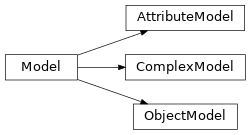Model configuration
Note
These classes aren’t meant to be instantiated directly. They are used for module config validation with OmegaConf Structured config and provided here as a general reference of module config file format.
Base model configuration entities
Savant base models
Base deep learning model configuration templates.

Model child classes

ModelOutput child classes
Base model configuration template. |
|
Model input parameters configuration template. |
|
Model output parameters configuration template. |
|
Object image preprocessing function configuration. |
|
Object model configuration template. |
|
ObjectModel output configuration template. |
|
ObjectModel output objects configuration template. |
|
Attribute model configuration template. |
|
AttributeModel output configuration template. |
|
AttributeModel output attribute configuration template. |
|
Complex model configuration template. |
|
ComplexModel output configuration template. |
Deepstream base models
Base configuration template for a nvinfer model. |
Deepstream model configuration
Gst-nvinfer model configuration templates.

Model hierarchy with nvinfer entities

Model output hierarchy with nvinfer entities
Note
The following classes specify configuration templates for fully realized concrete model types that can be included in the pipeline.
For example, base model types Model or NvInferModel
cannot be used in configuration, while their descendant NvInferDetector can.
Standard detector with orthogonal bboxes configuration template. |
|
NvInferAttribute model configuration template. |
|
NvInferComplexModel configuration template. |
|
nvinfer model input configuration template. |
|
NvInferObjectModel output configuration template for detector with aligned bboxes. |
|
NvInferObjectModel output objects configuration template. |
- class savant.deepstream.nvinfer.model.NvInferModelFormat(value)
Enum for format of the provided model file.
- CAFFE = 0
Caffe model.
- UFF = 1
UFF model.
- ONNX = 2
ONNX model.
- ETLT = 3
Nvidia TAO model.
- CUSTOM = 4
Other format.
- class savant.deepstream.nvinfer.model.NvInferModelType(value)
Enum for type of the model (
network-typein nvinfer configuration).- DETECTOR = 0
Detector model.
- CLASSIFIER = 1
Classification model.
- SEGMENTATION = 2
Semantic segmentation model.
- INSTANCE_SEGMENTATION = 3
Instance segmentation model.
- CUSTOM = 100
Custom model.